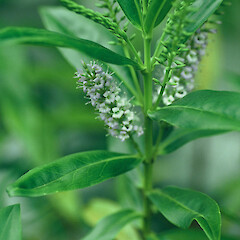Veronica breviracemosa
Common name
Kermadec koromiko
Synonyms
Hebe breviracemosa (W.R.B.Oliv.) Andersen, Hebe breviracemosa (W.R.B.Oliv.) Cockayne et Allan nom. superf., nom. illeg.
Family
Plantaginaceae
Flora category
Vascular – Native
Endemic taxon
Yes
Endemic genus
No
Endemic family
No
Structural class
Trees & Shrubs - Dicotyledons
Chromosome number
2n = 40
Current conservation status
The conservation status of all known New Zealand vascular plant taxa at the rank of species and below were reassessed in 2017 using the New Zealand Threat Classification System (NZTCS) – more information about this can be found on the NZTCS website. This report includes a statistical summary and brief notes on changes since 2012 and replaces all previous NZTCS lists for vascular plants.
Please note, threat classifications are often suggested by authors when publications fall between NZTCS assessment periods – an interim threat classification status has not been assessed by the NZTCS panel.
- Conservation status of New Zealand indigenous vascular plants, 2017 . 2018. Peter J. de Lange, Jeremy R. Rolfe, John W. Barkla, Shannel P. Courtney, Paul D. Champion, Leon R. Perrie, Sarah M. Beadel, Kerry A. Ford, Ilse Breitwieser, Ines Schönberger, Rowan Hindmarsh-Walls, Peter B. Heenan and Kate Ladley. Department of Conservation. Source: NZTCS and licensed by DOC for reuse under the Creative Commons Attribution 4.0 International licence.
2017 | Threatened – Nationally Vulnerable | Qualifiers: CD, EF, IE, OL
Previous conservation statuses
2012 | Threatened – Nationally Vulnerable | Qualifiers: CD, EF, IE, OL
2009 | Threatened – Nationally Critical | Qualifiers: CD, HI, OL, IE
2004 | Threatened – Nationally Critical
Brief description
Bushy shrub bearing pairs of thin oval leaves and flower spikes that are shorter than the leaves inhabiting the Kermadec Islands (Raoul Island only). Leaves to 112mm long by 26mm wide. Leaf bud with small narrow gap at base between leaves. Flowers white, with a very short tube.
Distribution
Endemic to Raoul Island, Kermadec Islands Group.
Habitat
Coastal cliffs and headlands, under sparse Kermadec pohutukawa (Metrosideros kermadecensis ) and Kermadec ngaio (Myoporum rapense subsp. kermadecense) forest.
Detailed description
Shrub up 2 x 1.5 m. Branches numerous, somewhat lax and spreading, often layering. Branchlets yellow-green, minutely puberulent. Leaf bud as long as mature leaves, with or without sinus, sinus ovoid to narrowly elliptic. Petiole 5-10 mm. Leaves spreading; 30-150 x 15-30 mm, yellow-green, green to dark-green, firmly fleshy, elliptic, lanceolate to oblong-lanceolate, apex acute to subacute, base attenuate to cuneate; lamina entire or with small teeth in upper third; glabrescent with fine pubescence along lamina margin. Inflorescences lateral, racemose, 20-30(-50) mm, shorter than surrounding leaves, mostly simple, sometimes compound with 1(-2) branches at base. Peduncle 5-15 mm long, peduncle and rachis puberulent. Basal bracts often leaf like 3-5 mm long, green. Flowers crowded, pale lilac. Calyx-lobes 4 x 1 mm. Corolla tube 1-1.5 mm, lobes 3 mm, ovate, acute, strongly recurving almost to calyx-lobes. Capsule 5 x 2.5 mm, grey-green, narrowly acute, glabrescent.
Similar taxa
Vegetative material could be confused with koromiko (Veronica stricta var. stricta) but Veronica breviracemosa is not as hairy, while the leaf bud of this species usually has a sinus. Flowering material easily separates this species from all other northern hebes with racemose inflorescences, as none of those species possess the combination of a short corolla tube, with the corolla lobes strongly curling back on themselves.
Flowering
In warmer parts of the country this species can flower throughout the year, further south it generally flowers during the summer months.
Flower colours
Lavender
Fruiting
Fruits may be found throughout the year but are more common in summer.
Propagation technique
Easily grown from seed, and cuttings. Seed is not freely produced by garden stock because this is mostly derived from a single seemingly male-dominant clone. This species hybridises easily in cultivation, so cutting grown material is the most reliable means of maintaining it.
Threats
Once thought to be extinct, this species is still extremely scarce on Raoul Island. Indeed the species was assumed to have been eliminated by goats. When the last goat was shot in 1983 on exactly the same day, a single hebe was rediscovered by a goat hunter! Until 1997 this was the only plant known from the wild, and all New Zealand material is derived from it. However, as part of a weed eradication programme, people abseiling the steep volcanic cliffs of Raoul discovered a further 50 plants. Cuttings and seedlings raised from these plants and the original discovery are now being planted across Raoul Island. Nevertheless the species still remains at severe risk of extinction, mainly through weed invasion of its unstable, volcanic cliff habitat.
Etymology
veronica: Named after Saint Veronica, who gave Jesus her veil to wipe his brow as he carried the cross through Jerusalem, perhaps because the common name of this plant is ‘speedwell’. The name Veronica is often believed to derive from the Latin vera ‘truth’ and iconica ‘image’, but it is actually derived from the Macedonian name Berenice which means ‘bearer of victory’.
Attribution
Fact sheet prepared for NZPCN by P.J. de Lange (28 July 2007). Description based on life material held by author supplemented with information obtained from Bayly & Kellow (2006)
References and further reading
Bayly, M.J.; Kellow, A.V. 2006: Hebes, identification, classification and biology. Wellington, Te Papa Press.
NZPCN Fact Sheet citation
Please cite as: de Lange, P.J. (Year at time of access): Veronica breviracemosa Fact Sheet (content continuously updated). New Zealand Plant Conservation Network. https://www.nzpcn.org.nz/flora/species/veronica-breviracemosa/ (Date website was queried)






